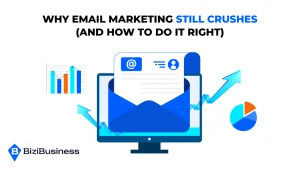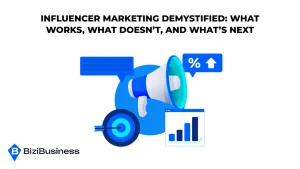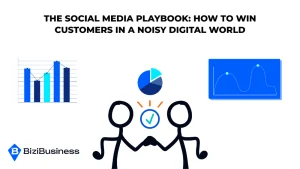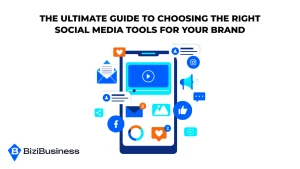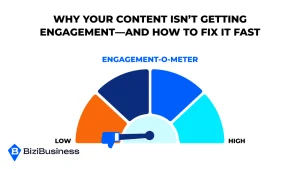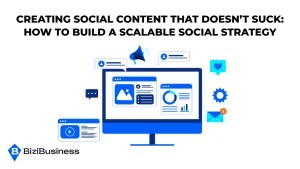BiziTopics
How to Turn Your Customers into Advocates with Affiliate Ads
BiziBusiness
Jul 8, 2025
21 min read
Imagine this:
You run a local business. You’ve worked hard to build your reputation in the community. People love your products, but you want to reach more locals without feeling pushy or sales-driven.
You’ve tried traditional ads—social media posts, flyers, even some paid campaigns. But they often feel generic or too salesy, and they don’t build the loyal following you’re hoping for.
What if, instead of pushing promotions, you could create a sense of community support?
What if your customers didn’t just buy from you—but actively advocated for your business?
That’s where affiliate ads come in.
Why Traditional Ads Don’t Build Local Loyalty
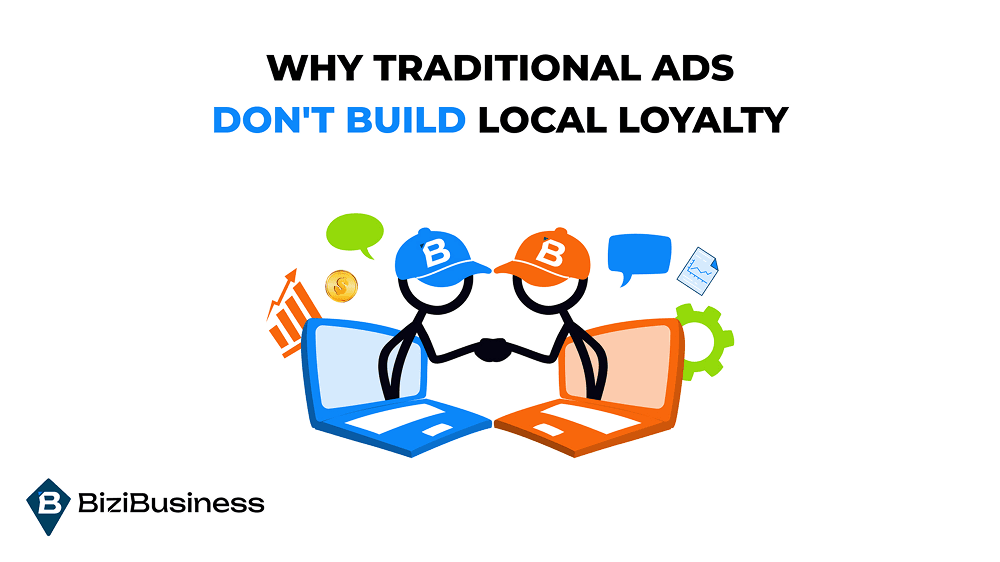
The problem with pushy promotions and generic messaging.
When you run a local business, your strength lies in community connection. People choose you over big brands because they feel a personal connection or trust your quality.
But here’s where traditional advertising often falls flat:
It feels impersonal, pushy, and disconnected from the local experience.
The Problem with Generic Ad Strategies
Think about it:
- You put up a flashy ad on social media: “Big Sale! Buy Now!”
- Or you send out a generic email blast about your latest products.
- Maybe you even put a banner ad on a local news site.
Sure, it might catch some eyes. But does it make people feel connected to your brand?
Often, these traditional ads feel like they’re shouting at people rather than inviting them in.
Why Hard-Sell Ads Turn Locals Away
Your community isn’t just a market—it’s made up of real people who value authenticity.
When your ads focus only on pushing products, they miss the mark.
Here’s why locals might not engage:
- Lack of Personal Connection: Ads that feel like they’re from a faceless corporation.
- Too Much Sales Pressure: Hard-sell tactics make people uncomfortable.
- Irrelevant Messaging: Focusing on deals rather than community stories or local relevance.
- No Sense of Community: Ads that feel transactional rather than relational.
Why Local Customers Support Businesses They Trust
Local consumers are different from online shoppers—they’re more likely to support businesses they feel invested in.
If your affiliate ads come off as genuine recommendations from community members rather than corporate sales pitches, they resonate more deeply.
Think about it:
Would you rather support a business because you saw a loud, flashy ad—or because a fellow local recommended it?
Shifting the Mindset: From Promotion to Partnership
Instead of bombarding your community with generic promotions, imagine your ad as an invitation to be part of something local and meaningful.
Affiliate ads give you the chance to:
- Feature real people: Customers, local influencers, and community members.
- Tell stories: How your product or service makes life better locally.
- Create advocates: People who don’t just buy but proudly promote your brand.
Why Local Advocacy Matters for Affiliate Success

When you think of affiliate marketing, you might picture influencers promoting brands online or bloggers recommending products through affiliate links.
But for a local business, affiliate ads work a little differently.
The goal isn’t just to sell—it’s to build a community of advocates.
These are people who don’t just purchase—they actively promote your business because they believe in it.
The Difference Between a Buyer and an Advocate
- A buyer might purchase once because of a good deal or a catchy ad.
- An advocate consistently supports your business, tells others about it, and shares their positive experiences—both online and offline.
For local businesses, it’s not enough to attract random customers through one-off ads. You need to nurture relationships that make people feel connected to your brand.
Affiliate marketing done right can transform satisfied customers into vocal advocates.
Why Advocacy Matters Locally
When people in your community see others talking about your business, it feels authentic and relatable.
- Social Proof: Seeing locals recommend your brand builds trust.
- Word-of-Mouth: Advocates naturally spread the word within their social circles.
- Community Support: People are more likely to support businesses that others in the community endorse.
Affiliate marketing isn’t just about getting clicks or quick sales.
It’s about creating sustained growth through community support.
Benefits of Turning Locals into Advocates:
- Repeat Business: Advocates come back because they feel invested.
- Organic Promotion: They talk about your business without being asked.
- Stronger Brand Loyalty: When they share your brand with others, they feel responsible for that recommendation.
- Positive Perception: It’s not just marketing—it’s storytelling through real voices.
Key Elements of Local Affiliate Ads That Build Trust
If it doesn’t feel genuine, it doesn’t work.
When it comes to affiliate ads for local businesses, the number one priority is trust.
Your community doesn’t just want to see promotions—they want to know that your recommendations are authentic and reliable.
Why does trust matter so much?
Because local customers value personal connections. If your ad feels forced or salesy, it breaks that connection.
Here’s how to create affiliate ads that feel real, relatable, and community-focused.
1. Authenticity: Sharing Real Experiences
People can sense when an ad feels scripted or fake.
If your affiliate ad sounds like a generic sales pitch, your audience will tune it out—or worse, distrust it.
How to Keep It Authentic:
- Feature Real People: Use local customers or community members who genuinely love your product.
- Share Personal Stories: Instead of just stating features, talk about how the product made life better.
- Avoid Hype: Stick to honest, relatable language.
Example:
Instead of “The Best Coffee in Town!” try “Why I Start Every Morning with a Brew from [Your Cafe].”
2. Storytelling: Make It Personal
Stories make people feel connected—they humanize your brand and make the product more relatable.
Rather than simply promoting a product, tell a story about how it’s used or why it matters.
How to Tell Stories Effectively:
- Customer Testimonials: Share how a regular customer discovered your product.
- Behind-the-Scenes: Show how your product is made or sourced locally.
- Problem and Solution: Describe a common problem and how your product solves it.
Example:
“As a local yoga instructor, finding a smoothie that keeps me fueled without weighing me down was a challenge. That’s why I love [Your Smoothie Shop]—it’s the perfect post-class pick-me-up!”
3. Relevance: Choose Products That Fit Your Community
If the products you promote don’t align with your local audience’s interests, the ad falls flat.
Choose items that naturally fit into your community’s lifestyle and values.
How to Keep It Relevant:
- Think Seasonally: Promote hot drinks in winter or cooling products in summer.
- Community Interests: If your town loves hiking, feature outdoor gear or snacks.
- Cultural Fit: Highlight products that resonate with local traditions or events.
Example:
During a local festival, promote picnic-friendly foods or on-the-go drinks.
4. Transparency: Be Honest About Your Partnerships
People don’t mind if a post is sponsored—as long as you’re upfront about it.
Being transparent builds trust and credibility.
How to Be Transparent:
- Clearly Label Your Ad: Use phrases like “In Partnership with” or “Sponsored by.”
- Explain the Relationship: Briefly mention why you partnered with the brand.
- Focus on Value: Emphasize how the product genuinely benefits your community.
Example:
“I’ve partnered with [Brand] because I genuinely love how their products support a healthy lifestyle. As always, opinions are my own!”
5. Value: Make It Worth Their Time
People don’t engage with affiliate ads just because they like your brand—they do it because the content itself is valuable.
Think about what your community needs or wants, and deliver on that.
How to Add Value:
- Offer Local Tips: Combine product promotion with advice (e.g., “Best Hiking Trails and the Snacks to Pack”).
- Share Discounts or Offers: Make your ad feel like an opportunity, not just an ad.
- Educational Content: Demonstrate how to use the product effectively.
Example:
“Here’s how I prepare for a long hike: 5 essentials—including my favorite local energy bars from [Brand]!”
6. Personalization: Speak Directly to Your Community
The more your ad feels like it’s made specifically for your audience, the more it resonates.
Avoid generic language that could apply anywhere—focus on local culture and experiences.
How to Personalize Your Ads:
- Mention Local Landmarks or Events: “Perfect for a day at [Local Park]!”
- Use Regional Terms or Dialects: Speak the way your community does.
- Highlight Local Benefits: Like supporting small businesses or keeping money in the community.
Example:
“Why locals are swapping their usual energy drinks for this natural alternative from [Local Store].”
When your community feels like they’re part of your story—not just a target—they’ll be more likely to support your business and spread the word.
Choosing the Right Affiliate Partners in Your Community
Collaboration that feels genuine, not forced.
When running affiliate ads as a local business, the partners you choose can make or break your campaign.
You want partners who don’t just have reach—but who genuinely connect with your community.
Why does it matter?
If your affiliate partner feels disconnected from your brand or the local vibe, it’s obvious—and it hurts credibility.
Here’s how to find and collaborate with people who can amplify your message without compromising trust.
1. Identify Local Influencers Who Are Trusted and Relatable
Not every influencer is a good fit for your local business.
Look for people who are already invested in the community and have an audience that overlaps with your customer base.
Who Makes a Good Local Partner?
- Community Leaders: People known for supporting local initiatives.
- Local Creators: Bloggers, YouTubers, or social media personalities who share content relevant to your niche.
- Neighborhood Heroes: Individuals who are well-regarded and influential, even if they don’t have massive followings.
- Micro-Influencers: People with smaller, but highly engaged local audiences.
2. Involve Your Current Customers as Advocates
Your loyal customers are often your best promoters.
When locals see someone they know sharing your products, it feels more credible than a paid influencer ad.
How to Involve Customers:
- Referral Programs: Offer incentives for sharing your products online.
- Social Shoutouts: Highlight customers who post about your brand.
- Feature Stories: Share their experiences in your content—like a regular customer who swears by your coffee before every shift.
3. Partner with Other Local Businesses
Collaborating with other small businesses can expand your reach while maintaining local credibility.
Find businesses that complement yours rather than compete.
Great Collaboration Ideas:
- Cross-Promotions: Offer a joint discount when customers visit both stores.
- Event Partnerships: Co-host local events and promote each other.
- Gift Bundles: Combine products from both businesses for seasonal or special packages.
4. Work with Community Groups or Nonprofits
Being involved in local causes boosts your reputation and shows you’re invested in the community.
Partnering with community groups also helps reach audiences that value local impact.
How to Do It Right:
- Charity Drives: Donate a portion of sales through affiliate links to a local cause.
- Sponsorships: Support community events with branded presence and samples.
- Cause Marketing: Collaborate with local organizations to create awareness while promoting your product.
5. Choose Partners Who Align with Your Values
Your community will notice if your affiliate partners don’t share your ethos or values.
For instance, if your brand focuses on sustainability, partnering with someone who doesn’t practice eco-friendly habits could backfire.
How to Vet Your Partners:
- Check their content: Make sure it aligns with your brand’s tone and message.
- Look at audience interaction: Are they respected and trusted by the community?
- Discuss expectations: Be clear about your brand’s values and what you want from the partnership.
6. Keep Communication Open and Collaborative
A successful partnership is built on clear communication and mutual benefit.
Don’t just dictate what your partners should do—invite their ideas and feedback.
How to Collaborate Effectively:
- Co-Create Content: Brainstorm ideas together to make sure it feels natural.
- Share Results: Keep partners updated on how the campaign is performing.
- Show Appreciation: Publicly thank them for their support.
Choosing the right affiliate partners is about more than just finding influencers—it’s about building authentic, community-focused relationships.
When your partners genuinely believe in your brand, their audience will too. And that’s when your affiliate ads stop feeling like ads—and start feeling like community recommendations.
Creating Authentic Affiliate Ads That Feel Community-Driven
Stop selling—start connecting.
Affiliate ads don’t work when they feel like ads.
For local businesses, the goal isn’t just to get clicks—it’s to build trust and a sense of belonging.
Why does authenticity matter?
Because your community values honesty. If your ad feels forced or salesy, it’ll get ignored—or worse, damage your reputation.
Here’s how to create affiliate ads that feel genuine, relatable, and community-driven.
1. Start with Real Stories, Not Sales Pitches
People don’t relate to sales language—they relate to stories.
When you share a personal experience or a community story, it feels honest and human.
How to Tell Real Stories:
- Customer Spotlight: Feature a regular customer who swears by your product.
- Local Experience: Share how your product fits into a typical day in the community.
- Partner Perspectives: Let your affiliate partners share why they personally recommend your business.
2. Focus on Benefits, Not Features
Your community doesn’t just want to know what you offer—they want to know why it matters to them.
Instead of listing features, emphasize how your product or service improves daily life.
How to Highlight Benefits:
- Use Local Context: “Perfect for busy mornings in [Your Town]!”
- Focus on Solutions: “No more rushing around for breakfast—grab a smoothie to go!”
- Show Real Impact: “Here’s how our eco-friendly products help our community stay green.”
3. Use Visuals That Blend In, Not Stand Out
Your visuals should feel like they’re part of the organic content flow, not a disruptive ad.
Choose images or videos that reflect real life rather than overly polished, corporate visuals.
How to Make Visuals Feel Authentic:
- Use Real Photos: Candid shots of customers enjoying your product.
- Show Local Landmarks: Integrate familiar settings to make the ad feel more personal.
- Behind-the-Scenes Content: People love seeing how things are made or prepared.
4. Write Like You Talk: Conversational and Casual
Affiliate ads should sound like a friendly recommendation, not a scripted promotion.
Avoid jargon or overly formal language. Instead, write as if you’re chatting with a neighbor.
How to Keep It Casual:
- Use First-Person Narration: “I tried it, and here’s why I loved it.”
- Be Honest About Your Experience: “I wasn’t sure at first, but it turned out to be amazing!”
- Incorporate Local Slang: If your community has a way of speaking, lean into it.
5. Make the Call to Action (CTA) Feel Like an Invitation
Instead of demanding a purchase, invite people to join in.
Your CTA should feel like a suggestion rather than a command.
Community-Friendly CTA Ideas:
- Join Us: “Come see why locals love our weekend brunch!”
- Try It for Yourself: “Pop in and taste the difference—first cup’s on us!”
- Get Involved: “Tag us in your next visit for a chance to be featured!”
6. Create Interactive or User-Generated Content (UGC)
Encourage your community to share their own experiences. This not only boosts engagement but also shows that your business is part of their lives.
Ideas for Interactive Content:
- Challenges: “Show us your favorite way to enjoy our smoothies—tag us to be featured!”
- Polls and Questions: “What’s your go-to comfort food from our menu?”
- Repost UGC: Share your customers’ photos and stories to build social proof.
Building Long-Term Relationships with Local Affiliates and Customers
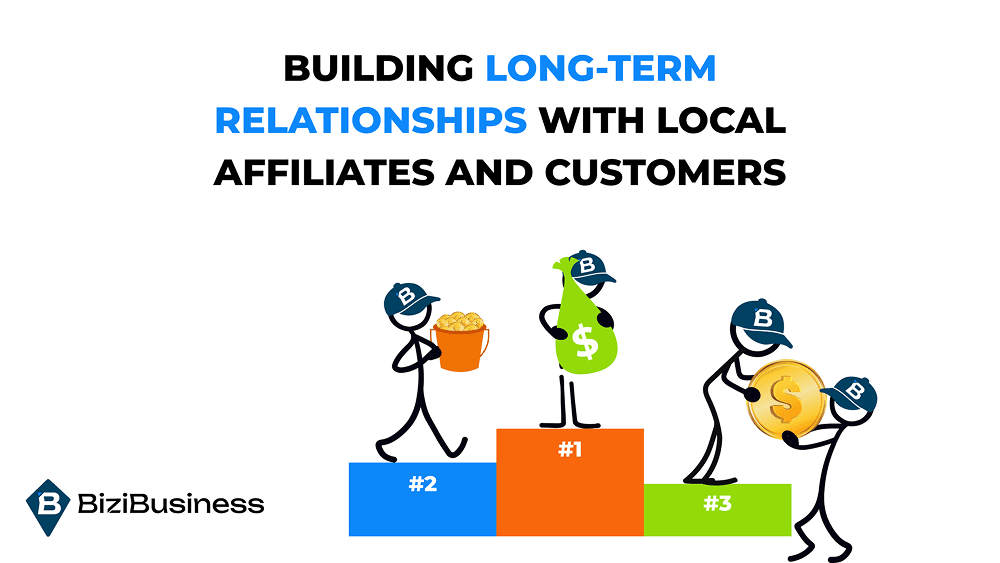
Your community is more than a transaction—it’s a partnership.
Creating successful affiliate ads isn’t just about running a single campaign.
It’s about building lasting relationships with both your partners and your customers.
Why focus on relationships?
Because when people feel valued, they’re not just customers—they’re advocates.
And when your affiliates feel genuinely appreciated, they’ll keep promoting your business with enthusiasm.
Here’s how to build relationships that last.
Keep Your Affiliate Partners Engaged and Appreciated
One of the biggest mistakes local businesses make is treating affiliates like temporary promoters rather than long-term collaborators.
To keep them invested, show that you value their efforts beyond just the campaign.
- Regular Check-Ins: Reach out even when there’s no campaign running. Ask how they’re doing and share business updates.
- Exclusive Perks: Offer special discounts or early access for affiliates to make them feel like insiders.
- Shoutouts and Recognition: Publicly thank your affiliates on social media and in your newsletters.
- Feedback Loop: Involve them in brainstorming sessions—ask for their ideas on new campaigns.
Foster a Sense of Community Among Your Affiliates
If your affiliates feel like they’re part of a community rather than isolated promoters, they’ll be more invested.
Create opportunities for them to connect, collaborate, and share ideas.
- Host Local Meetups: Bring your affiliates together for coffee, workshops, or brainstorming sessions.
- Create a Private Group: Set up a group chat or social media group where affiliates can share tips and ideas.
- Celebrate Success Together: Highlight wins and achievements, whether it’s a great campaign or a personal milestone.
Offer Ongoing Support and Resources
Your affiliates will perform better if they’re equipped with the right tools and guidance.
Make sure they always have access to up-to-date information, content, and insights.
- Create a Resource Hub: Include logos, product images, and copy templates they can easily use.
- Offer Training: Host workshops or share videos on best practices for promoting your products.
- Provide Performance Insights: Share data on what’s working and how they can improve.
Stay Transparent and Honest About Results
Affiliates appreciate openness about how the campaign is performing.
If something isn’t working, involve them in finding a solution rather than just making changes without their input.
- Share Regular Updates: Even if numbers are lower than expected, honesty builds trust.
- Ask for Feedback: Let affiliates share what they think could improve.
- Be Clear About Changes: If you’re tweaking a strategy, explain why.
Keep Customers in the Loop, Too
Your loyal customers are part of your community, and they should feel like more than just buyers.
When you involve them in your affiliate journey, they’ll feel more connected and more likely to support both your business and your partners.
Build a Culture of Appreciation
A simple “thank you” can go a long way.
Your affiliates are an extension of your brand—acknowledge their contributions consistently.
- Handwritten Notes: A personal touch makes a big difference.
- Holiday Gifts: Even small tokens show you care.
- Affiliate of the Month: Feature someone who’s gone above and beyond.
- Personal Messages: Don’t just automate your gratitude—make it personal.
Building long-term relationships with your local affiliates and customers isn’t just good business—it’s essential for lasting success.
The Best Platforms for Local Affiliate Ads
Meet your audience where they already hang out.
Choosing the right platform for your local affiliate ads is crucial.
You want to be on platforms that feel natural for your community and where people are already engaging with local content.
Let’s break down the most effective platforms for local affiliate marketing and how to use them.
Social Media: Engaging Your Community Where They Scroll
Social media platforms are a natural fit for affiliate ads because they allow you to connect with your community in real time.
You can use social media to promote events, new products, and community stories.
Local Blogs and Websites: Community-Centered Content
Many towns and cities have local bloggers who focus on food, lifestyle, events, or community stories.
Partnering with these bloggers can make your affiliate ads feel more like recommendations than promotions.
Email Newsletters: Direct and Personal Engagement
People still read emails—especially when they’re from trusted local sources.
Include affiliate content that feels like a personal tip or update rather than a hard sell.
Hyperlocal Platforms: Connecting Neighborhoods
Some platforms are specifically designed to connect local communities. These are perfect for targeting a small, dedicated audience.
Video Platforms: Real Stories, Real Impact
People love seeing authentic, relatable content—and video is the perfect medium.
Use platforms that allow for short, impactful clips or longer storytelling.
Offline and In-Store Integrations: Bridging Online and Real Life
Your affiliate strategy doesn’t have to be exclusively online.
Tie your online affiliate promotions to real-world interactions.
By meeting your audience where they already are, your affiliate ads will feel natural, relevant, and community-driven—not forced or out of place.
Measuring Success: Are Your Local Customers Becoming Advocates?
It’s not just about clicks—it’s about connection.
After putting effort into creating and running local affiliate ads, it’s crucial to evaluate their effectiveness.
But unlike purely digital campaigns, local affiliate ads aren’t just about impressions and clicks.
They’re about building relationships, loyalty, and community support.
Let’s break down the key metrics and methods to gauge whether your affiliate strategy is actually building that local connection.
Engagement Metrics: Are People Actually Interacting?
Clicks are great, but they only tell you that someone noticed your ad.
What really matters is whether people are engaging with your content and sharing it with others.
What to Track:
- Social Media Interactions: Likes, comments, shares, and tags related to your affiliate posts.
- Event Participation: Sign-ups or attendance generated from affiliate campaigns.
- Community Involvement: Are locals talking about your campaign in community groups or forums?
How to Measure:
- Use social media analytics to track interactions and mentions.
- Set up UTM codes to see how much traffic affiliates generate.
- Ask your affiliates to report community feedback and insights.
Sentiment Analysis: What Are People Saying?
It’s not just about the volume of engagement—it’s about the quality.
You want to know how people feel about your campaign.
What to Track:
- Comments and Feedback: Are responses positive, neutral, or negative?
- Reviews and Testimonials: Are people sharing positive experiences tied to your affiliate efforts?
- Brand Mentions: Are affiliates and customers tagging your business in a positive light?
How to Measure:
- Use social listening tools to track brand mentions and analyze sentiment.
- Encourage affiliates to share screenshots of comments and feedback.
- Look at review sites to see if your campaign sparked any mentions.
Conversion Metrics: Are Advocates Driving Sales?
While building relationships is essential, you still need to track sales directly linked to your affiliate efforts.
This helps you understand not just who’s engaging but who’s buying.
What to Track:
- Affiliate Link Clicks: How many users are visiting your site from affiliate content.
- Promo Code Redemptions: Unique codes given to specific affiliates to track their influence.
- In-Store Mentions: If customers reference a specific affiliate or campaign when visiting.
How to Measure:
- Track link clicks with UTM codes or custom URLs.
- Monitor sales tied to specific promo codes.
- Train staff to ask, “How did you hear about us?” and note the responses.
Customer Retention: Are They Coming Back?
A successful local affiliate campaign doesn’t just drive one-time visits.
You want to see customers returning and becoming regular supporters.
What to Track:
- Repeat Visits: Are customers who came from affiliate ads coming back?
- Loyalty Program Sign-Ups: Did your campaign encourage people to join?
- Follow-Up Engagement: Are they interacting with your brand post-purchase?
How to Measure:
- Use your POS system to track repeat customers.
- Offer loyalty incentives tied to affiliate-driven visits.
- Survey customers about why they returned—was it because of a specific promotion?
Brand Loyalty Indicators: Are They Becoming Advocates?
Beyond sales and clicks, the true test is whether your local community starts championing your brand.
These are the signs that your affiliate efforts have moved beyond simple promotion to building a network of supporters.
What to Track:
- Social Media Advocacy: Are locals voluntarily sharing your content?
- Word-of-Mouth Mentions: Are people recommending you to their friends and family?
- Affiliate-Led Community Events: Are people excited to participate?
How to Measure:
- Track the increase in community-driven content (like UGC).
- Monitor referrals that mention affiliates by name.
- Listen for organic buzz in local online groups or community boards.
Affiliate Satisfaction: Are Your Partners Happy?
If your affiliates feel valued and successful, they’ll continue advocating for your brand.
A happy affiliate is an active affiliate.
What to Track:
- Affiliate Feedback: Are they satisfied with the partnership?
- Performance Reports: Are they seeing positive engagement and results?
- Collaboration Willingness: Are they open to working with you again?
How to Measure:
- Conduct quick surveys or feedback sessions.
- Offer incentives for continued collaboration.
- Recognize and reward top-performing affiliates.
Building a Community-Driven Affiliate Strategy
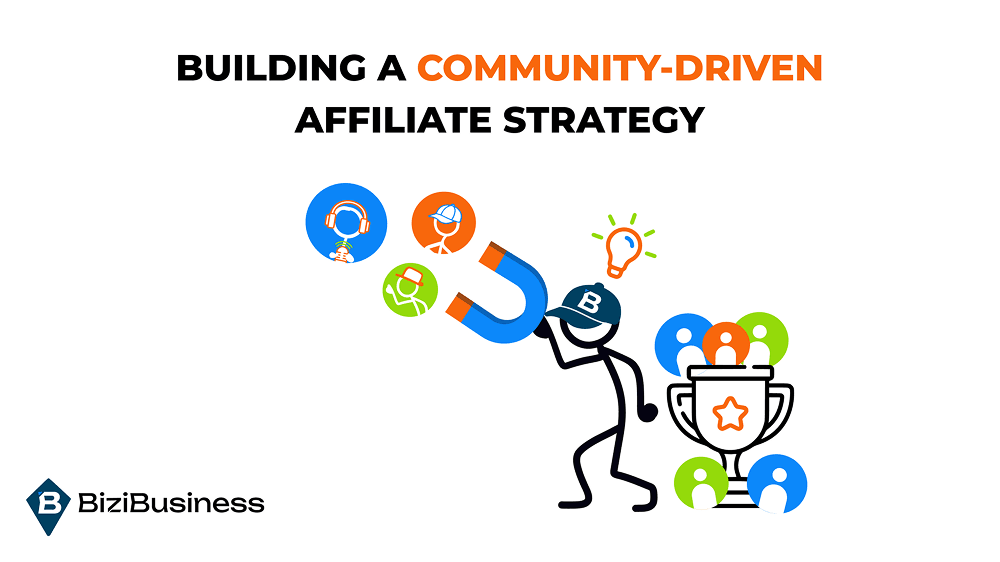
It’s not just about sales—it’s about creating local champions.
Affiliate marketing for local businesses is more than just a way to boost revenue.
It’s an opportunity to strengthen connections within your community and transform customers into enthusiastic advocates.
By focusing on authenticity, collaboration, and community engagement, you’re not just running ads—you’re nurturing a community that believes in your brand.
And when your customers and affiliates feel valued, they’ll naturally support your business—not just as buyers but as champions of your success.
Start building your community-driven affiliate strategy today—and watch your local presence grow stronger with every new advocate.
Subscribe to Newsletter
Unlock your creativity and stay up to date on marketing tips
